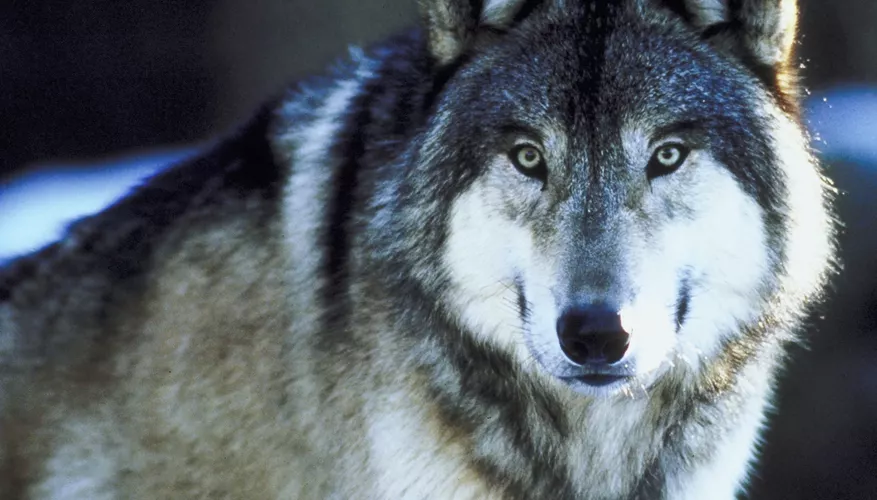The timber wolf (Canis lupus), often referred to as the gray wolf, is a wild canine species that commands respect due to its fierce reputation. Despite their intimidating image, timber wolves typically avoid human interaction, although they are known to prey on a variety of animals, from reindeer to rabbits.

Timber wolves are frequently called gray wolves, though their color can vary. While they are typically brownish-gray with hints of yellowish-beige on their underbellies and faces, they may also exhibit fur in shades of black, brown, and white. These majestic animals usually range from 3 to 5 feet in length, with males typically being much larger than females. Male timber wolves weigh between 70 and 145 pounds, while females tend to weigh between 60 and 100 pounds.
In terms of physical appearance, timber wolves share similarities with domestic dog breeds like malamutes and German shepherds. Wolf packs generally consist of five to nine individuals, and their reproductive season takes place between January and February.
| Timber Wolf Characteristics | Details |
|---|---|
| Coloration | Brownish-gray with yellowish-beige underbellies, and black, brown, or white fur |
| Size | 3 to 5 feet in length |
| Male Weight | 70 to 145 pounds |
| Female Weight | 60 to 100 pounds |
| Pack Size | Typically 5 to 9 wolves |
| Reproduction Season | January to February |
Historically, timber wolves held the title of having the widest geographic range of any animal species. According to the IUCN Red List of Threatened Species, this is no longer true, as their range has drastically reduced over time. Timber wolves are now absent from many parts of North America and Western Europe. However, they can still be found in select regions of Canada, Alaska, Asia, and Europe.
Other countries where timber wolves are found include China, Germany, Romania, Greenland, France, and Armenia. In the United States, timber wolves currently reside only in a few states, such as Michigan, Wisconsin, Montana, and Alaska.
| Timber Wolf Range | Regions Found |
|---|---|
| North America | Alaska, Michigan, Wisconsin, Montana, parts of Canada |
| Europe | Germany, Romania, France, Armenia |
| Asia | Russia, parts of China |
| Other | Greenland |
Timber wolves are highly adaptable animals, capable of living in a variety of habitats. They are commonly found in environments that are distant from human settlements. These versatile creatures thrive in taigas, prairies, forests, tundras, brushlands, grasslands, mountains, and even deserts. Their adaptability to different environments is one of the reasons why timber wolves have been able to survive in such diverse regions, despite their declining numbers in some areas.
| Timber Wolf Habitat | Types of Habitats |
|---|---|
| Forest | Forests with dense trees and undergrowth |
| Taiga | Cold, northern forests |
| Tundra | Arctic and sub-Arctic regions |
| Prairie | Grasslands and open fields |
| Mountains | Rocky and hilly terrain |
| Desert | Dry, arid landscapes |
As carnivorous creatures, timber wolves primarily hunt for large prey, including musk oxen, bison, elk, moose, wild boar, and caribou. They are skilled hunters, relying on their pack dynamics and stamina to bring down larger animals. In addition to these prey, they occasionally consume the rotting remains of dead animals.
In areas where prey is scarce, timber wolves may also rummage through garbage cans in search of food. They can make do with whatever sustenance they find, particularly in colder climates.
| Timber Wolf Diet | Types of Prey |
|---|---|
| Primary Diet | Musk oxen, bison, elk, moose, wild boar, caribou |
| Occasional Diet | Rotting remains of dead animals, garbage |
| Hunting Behavior | Hunt in packs, relying on stamina and strategy |
Timber wolves, or gray wolves, are remarkable creatures that can adapt to a wide variety of habitats. Though their range has diminished over time, they remain an essential part of the ecosystem in regions across North America, Europe, and Asia. These wolves are carnivores, feeding on large prey and utilizing their remarkable hunting skills. Whether living in forests, taigas, or deserts, timber wolves continue to inspire awe with their resilience and adaptability.
animal tags: timberwolves graywolves
We created this article in conjunction with AI technology, then made sure it was fact-checked and edited by a Animals Top editor.